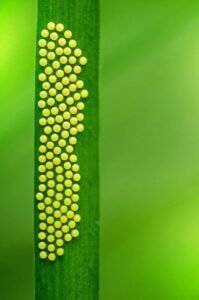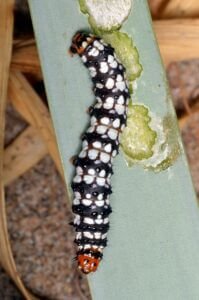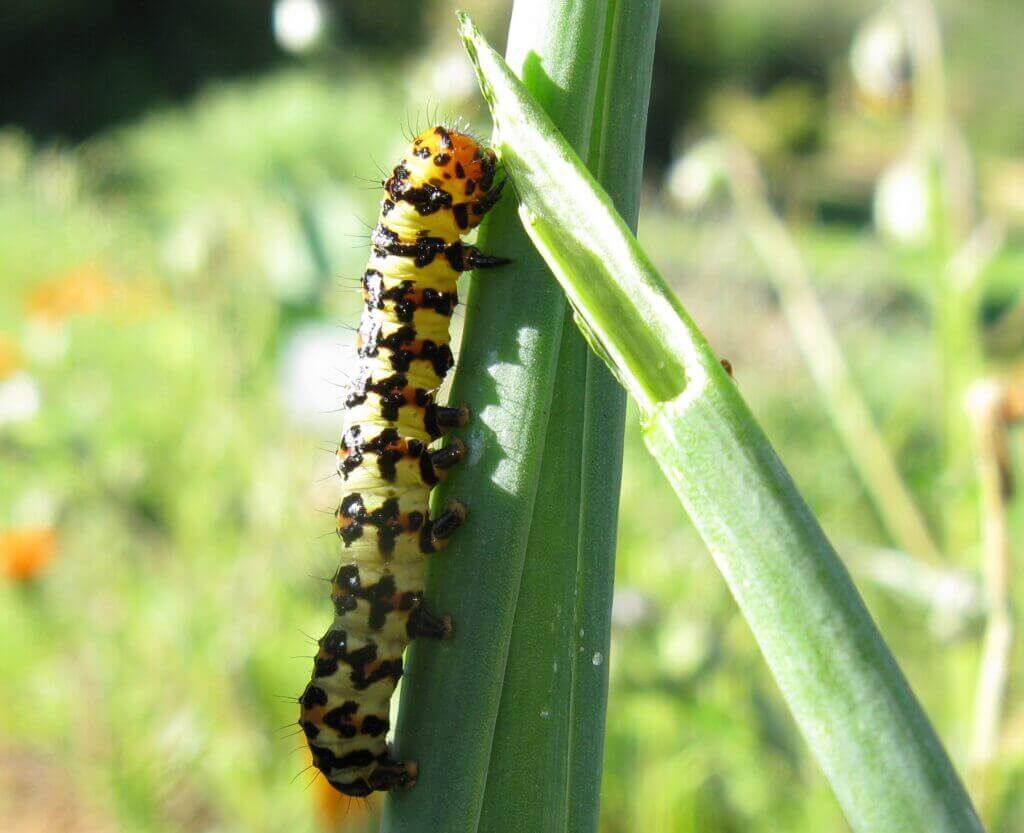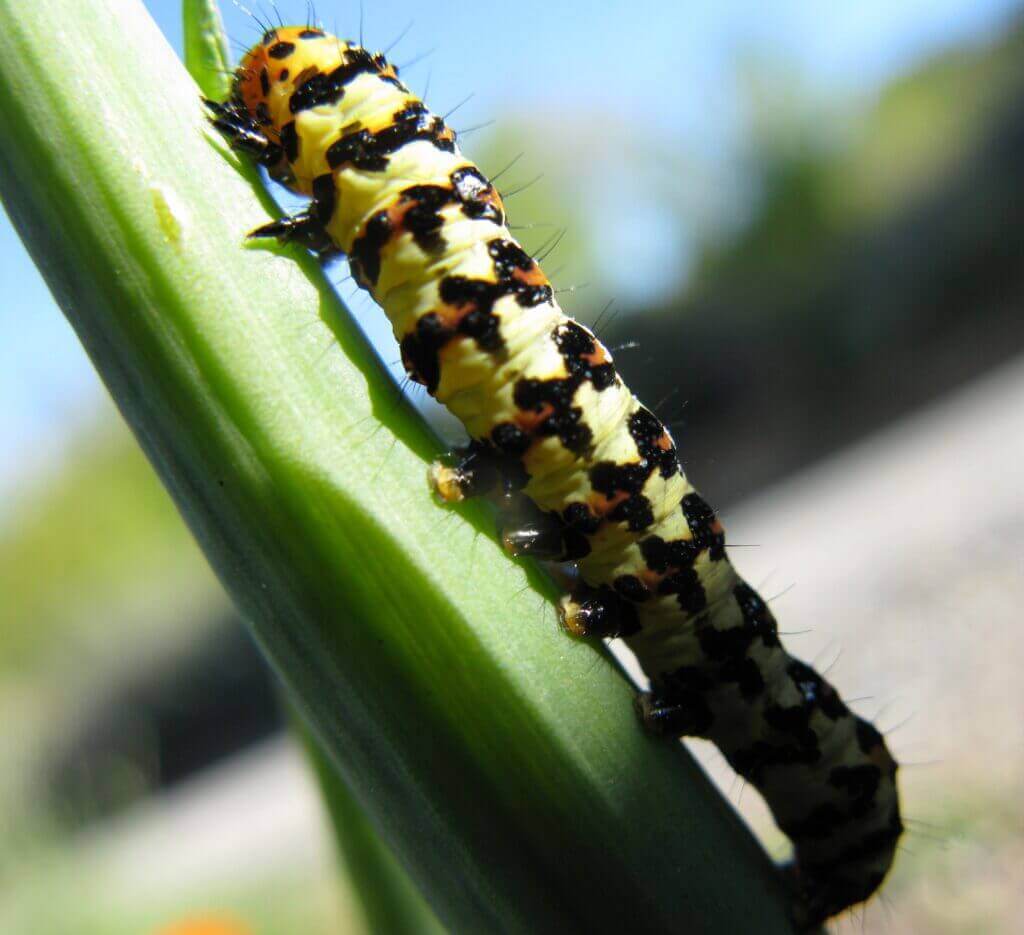How to Treat Lily Borer (Brithys crini)
The Lily Borer, scientifically known as Brithys crini, is a formidable pest in many South African gardens. This black and yellow worm, notorious for its appetite for lilies and related plants, poses a significant challenge. Understanding the lifecycle, habits, and effective control measures for this borer is vital for maintaining a healthy garden. This article aims to provide insightful and practical advice to combat Lily Borers in South Africa
Understanding the Lily Borer
What is the Lily Borer?
The Lily Borer, or Brithys crini, is a pest specifically known for targeting lilies and their relatives. Gardeners often spot them as striking black and yellow worms, which are, in fact, the larval stage of a nocturnal moth. These caterpillars can cause extensive damage to plants, leading to wilting, discoloration, and even the death of the plant if left unchecked.
The Lifecycle of Brithys crini
Understanding the lifecycle of the Lily Borer is key to effective control. The cycle begins with the adult moth laying eggs on the leaves of the host plant. These eggs hatch into the familiar black and yellow caterpillars. The larvae feed voraciously, often burrowing into the stems and leaves, causing visible damage. After reaching maturity, they descend into the soil to pupate and later emerge as adult moths, thus completing the cycle.

Identifying Lily Borer Infestations
Early identification of Lily Borer infestations is crucial. Look for signs like holes in the leaves, black frass (caterpillar droppings), and the presence of the distinctive caterpillars themselves. These signs typically become more evident during the warmer months when the larvae are most active.The damage inflicted includes leaves riddled with holes and missing sections. Tunnels within the leaves are also common, created by larvae that have hatched and fed their way into the bulb.Without intervention, these pests can ultimately lead to the death of the entire plant. Bulbous plants that collapse are often a clear indication of a lily borer invasion. However, by this stage, it may be too late to rescue the affected plant.
When are Lily Borers Active
In South Africa, the larvae of the Lily Borer, also known as Brithys crini, are typically most active during the warmer months. This usually corresponds to the spring and summer seasons, which in South Africa are from September to February. During this period, the warmer temperatures and increased plant growth provide ideal conditions for the larvae to feed and develop. Gardeners should be particularly vigilant during these months for signs of infestation.
Plants at Risk of Lily Boarer Infestations
While the name suggests a preference for lilies, Brithys crini is not exclusive to them. Other plants at risk include amaryllis, clivias, agapanthus, crinums, haemanthus, and other summer bulbs. Gardeners should monitor these plants closely, especially during the active months of the borer.



How to Prevent Lily Borers
Managing these pests involves proactive measures. Begin applying treatments in mid-September, with two applications each month until March. Suitable products include Margaret Roberts Biological Caterpillar Insecticide or Makhro Cyper. It’s best to spray these in the late evening or at night.
How to Control and Treat Lily Borer: Targeted Solutions for Lily Borer Infestations
When natural and preventative methods fall short, turning to chemical controls can be an effective way to manage Lily Borer populations. It’s essential to select products that are both potent against Lily Borers and safe for your plants and the environment.
-
Insecticides for Immediate Relief: Products containing pyrethroids, such as cypermethrin or permethrin, can offer immediate relief. These insecticides target the nervous system of the caterpillars, effectively reducing their population. However, it’s crucial to follow the manufacturer’s guidelines to ensure safe and effective use.
-
Systemic Insecticides for Long-term Protection: Systemic insecticides, absorbed by the plant, offer long-term defense against Lily Borers. Compounds like imidacloprid or acetamiprid are known for their efficacy. They are applied to the soil and absorbed by the plant, reducing potential harm to non-target insects.
-
Eco-Friendly Options: For gardeners preferring environmentally friendly solutions, organic options like neem oil and Bacillus thuringiensis (Bt) are excellent. Neem oil acts as both a repellent and a growth regulator for caterpillars, while Bt is a naturally occurring bacterium lethal to caterpillars but harmless to other wildlife.
Application Tips
When applying any pest control product:
- Always wear protective gear, such as gloves and masks.
- Apply during cooler parts of the day to minimize evaporation and increase effectiveness.
- Avoid overuse, which can lead to resistance in pests and harm beneficial organisms.
Integrated Pest Management (IPM)
Consider adopting an Integrated Pest Management (IPM) approach. IPM combines cultural, biological, and chemical tools in a way that minimizes economic, health, and environmental risks. This includes monitoring pest levels, using targeted treatments, and maintaining garden health through good practices.
Lily Borer (Brithys Crini) Q&A
Frequintly asked questions about Lily Borer (Brithys Crini):
Where Do Lily Borers Come From?
Lily borers, scientifically known as Brithys crini, are a common pest in South Africa, originating from the Mediterranean region. These pests are particularly attracted to lilies and other members of the Amaryllidaceae family. They thrive in warmer climates and can quickly infest gardens, especially where their preferred host plants are abundant.
What Does a Lily Borer Look Like?
A lily borer caterpillar is quite distinctive. It has a black body with striking yellow stripes running longitudinally along its length. As it matures, it can grow up to 4 cm long, making it quite noticeable on the leaves and stems of plants. The adult moth is less conspicuous, with a wingspan of about 40 mm, and is greyish-brown in color.
What Are the Black and Yellow Worms on My Plants?
The black and yellow worms you’re noticing on your plants are likely lily borers. These caterpillars are the larval stage of the Brithys crini moth. They are notorious for causing significant damage to lilies and related plants, as they feed voraciously on the leaves, stems, and sometimes even the bulbs.
Are Brithys Crini Poisonous?
Brithys crini, or lily borers, are not poisonous to humans or pets. However, their presence can be detrimental to plant health. They can cause extensive damage to lilies and other plants by feeding on them, which can lead to the weakening or death of the plant if the infestation is severe.
How Do I Get Rid of Lily Borers?
To control lily borers in South Africa, regular inspection of plants is crucial. Remove and destroy any eggs, larvae, or pupae you find. Biological control methods, such as introducing natural predators like wasps, can also be effective. For severe infestations, chemical control may be necessary, using registered insecticides specifically targeting caterpillars.
What Is the Best Spray for Borers?
In South Africa, the best sprays for controlling borers, including lily borers, are those containing active ingredients like cypermethrin or lambda-cyhalothrin. Always choose a product registered for use against caterpillars and follow the manufacturer’s instructions for application. It’s essential to apply these sprays at the first sign of infestation for effective control.
What Kills Root Borers?
To combat root borers, systemic insecticides that are absorbed by the plant can be effective. Products containing imidacloprid or thiamethoxam are often used in South Africa. These chemicals work by poisoning the borers as they feed on the treated plant. Always adhere to the recommended usage and safety guidelines when using systemic insecticides.
Is Neem Oil Good for Borers?
Neem oil can be an effective organic solution against borers, including lily borers. It works as an insect repellent and also disrupts the life cycle of the pests. Regular application of neem oil solution on affected plants can help in controlling the infestation. However, it may not be as immediately effective as synthetic insecticides and requires consistent application.
Conclusion on How to Control Lily Borers
In conclusion, tackling Lily Borer infestations in South African gardens requires a comprehensive approach that includes prevention, early intervention, and effective treatment. By staying vigilant and employing a mix of strategies, gardeners can protect their lilies and related plants from these destructive pests.


The Amaryllis borer has already burrowed into a section of the bulb. What can save the bulb?